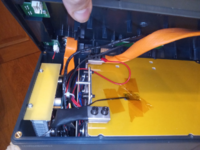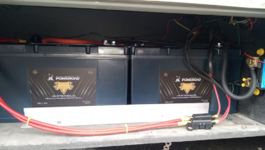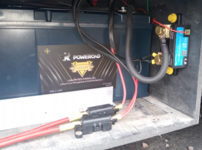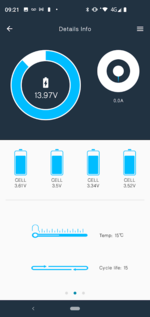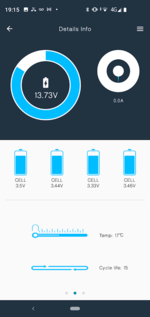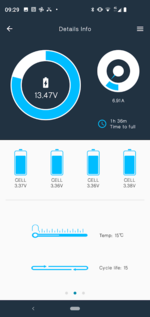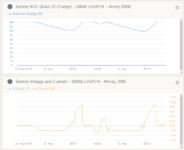wildebus
Full Member
- Messages
- 7,449
I did a bit of testing a week or so back on a pair of batteries that I will be fitted next week on a Motorhome and thought it might be of interest to the membership....
Batteries in question are the Poweroad Linc Infinity SubZero LiFePO4 Batteries. These are 100Ah rated and have a Bluetooth BMS and Internal Heating Pads, so pretty well specified. (they also have an RS488 Comms Port but don't think there is a device from Poweroad to use that yet, but a possible bit of futureproofing there?)
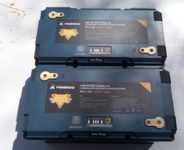
I wanted to do a capacity test to check what they will deliver. I decided to put a constant load on each battery in turn, run it until the Victron SmartShunt reported the SOC as 20% (so 80Ah taken out the battery) and then see what the "real" capacity was by reading the Batteries own SOC via the BT app (The difference is the extra undeclared capacity that most good Lithium batteries have).
First off is the 'Red' Battery.
A very consistant load of 3.4A (a 40W lightbulb on an 300W Inverter) and test stopped at 20% SOC according to the SmartShunt, and going to the internal Battery Monitor, we have a SOC of 29%. This indicates the 'real' capacity of the battery is about 109Ah (80Ah taken out, 29% of the batteries "100Ah" remaining)
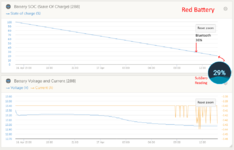
When looking at the graph there is an interesting drop in voltage around the 65% mark and then it levels out. Intriging.
Onto the 'Purple' Battery.
Identical test load and again taken down to around 20%. Here we have an internal Battery Monitor reading of 27% at the SmartShunts 20% level, so very similar.
The graph scales are a little different, so the lines may appear to look a bit different in the drop, but we have an identical voltage drop at around the 65% SOC level. That is good as shows total consistancy between the batteries.
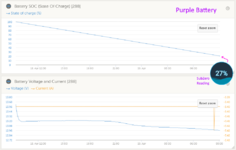
I am saying the batteries true capacity is around the 107-109Ah mark? That is not strictly right as once these batteries have gone though a few charge cycles, the capacity will actually increase by a few Ah, so you expect potentially maybe 115Ah?
I only did a single discharge test on each one to see what to expect on these batteries, but I think they are pretty nice
Here are some of screenshots of the BMS Data and Info available ...
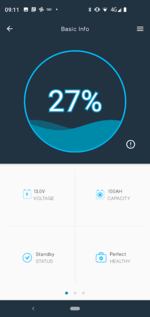
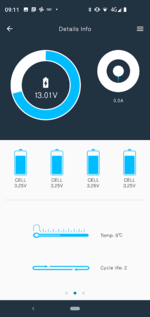
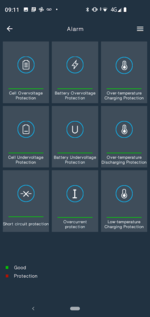
The other aspect of Lithium as well as their discharge ability is the claim they can recharge quickly? So I also put that to the test ...
After taking 80Ah out the battery, I connected a Victron 30A IP22 Smart Charger to it and with the Smart Shunt was able to see how the battery accepted the charge and how long it took.
I have to say that is a very impressive recharge! The limiting factor here will be the charger output of 30A and as can be seen that is a rock solid level line of 30A for 2 Hours 40 minutes, and only then does it tail off in the last 6 minutes of the charge and the voltage goes to the set 14.2V value.

So that is that. I know the SubZero batteries have been mentioned a fair bit on the forums and so I thought it worth sharing some semi real-world info
Batteries in question are the Poweroad Linc Infinity SubZero LiFePO4 Batteries. These are 100Ah rated and have a Bluetooth BMS and Internal Heating Pads, so pretty well specified. (they also have an RS488 Comms Port but don't think there is a device from Poweroad to use that yet, but a possible bit of futureproofing there?)

I wanted to do a capacity test to check what they will deliver. I decided to put a constant load on each battery in turn, run it until the Victron SmartShunt reported the SOC as 20% (so 80Ah taken out the battery) and then see what the "real" capacity was by reading the Batteries own SOC via the BT app (The difference is the extra undeclared capacity that most good Lithium batteries have).
First off is the 'Red' Battery.
A very consistant load of 3.4A (a 40W lightbulb on an 300W Inverter) and test stopped at 20% SOC according to the SmartShunt, and going to the internal Battery Monitor, we have a SOC of 29%. This indicates the 'real' capacity of the battery is about 109Ah (80Ah taken out, 29% of the batteries "100Ah" remaining)

When looking at the graph there is an interesting drop in voltage around the 65% mark and then it levels out. Intriging.
Onto the 'Purple' Battery.
Identical test load and again taken down to around 20%. Here we have an internal Battery Monitor reading of 27% at the SmartShunts 20% level, so very similar.
The graph scales are a little different, so the lines may appear to look a bit different in the drop, but we have an identical voltage drop at around the 65% SOC level. That is good as shows total consistancy between the batteries.

I am saying the batteries true capacity is around the 107-109Ah mark? That is not strictly right as once these batteries have gone though a few charge cycles, the capacity will actually increase by a few Ah, so you expect potentially maybe 115Ah?
I only did a single discharge test on each one to see what to expect on these batteries, but I think they are pretty nice
Here are some of screenshots of the BMS Data and Info available ...



The other aspect of Lithium as well as their discharge ability is the claim they can recharge quickly? So I also put that to the test ...
After taking 80Ah out the battery, I connected a Victron 30A IP22 Smart Charger to it and with the Smart Shunt was able to see how the battery accepted the charge and how long it took.
I have to say that is a very impressive recharge! The limiting factor here will be the charger output of 30A and as can be seen that is a rock solid level line of 30A for 2 Hours 40 minutes, and only then does it tail off in the last 6 minutes of the charge and the voltage goes to the set 14.2V value.

So that is that. I know the SubZero batteries have been mentioned a fair bit on the forums and so I thought it worth sharing some semi real-world info

